
|
Keywords: clouds, Neptune
 A Hole Punch Cloud Over Alabama
A Hole Punch Cloud Over Alabama
12.01.2004
What could create a huge hole the clouds? Such a hole, likely hundreds of meters across, was photographed last month from a driveway near Mobile, Alabama, USA. Very unusual to see, hole-punch clouds like this are still the topic of meteorological speculation. A leading hypothesis holds that the hole-punch cloud is caused by falling ice-crystals.
 Aurora Over Clouds
Aurora Over Clouds
10.09.2003
Aurorae usually occur high above the clouds. The auroral glow is created when fast-moving particles ejected from the Sun impact air molecules high in the Earth's atmosphere. An oxygen molecule, for example, will glow in a green light when reacquiring an electron lost during a collision with a solar particle.
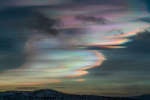 Nacreous Clouds over Lapland
Nacreous Clouds over Lapland
9.02.2023
Vivid and lustrous, wafting iridescent waves of color wash across this skyscape from Kilpisjцrvi, Finland. Known as nacreous clouds or mother-of-pearl clouds, they are rare. But their unforgettable appearance was captured looking south at 69 degrees north latitude at sunset on January 24.
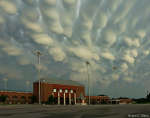 APOD: 2023 February 12 Б Mammatus Clouds over Nebraska
APOD: 2023 February 12 Б Mammatus Clouds over Nebraska
12.02.2023
When do cloud bottoms appear like bubbles? Normally, cloud bottoms are flat. This is because moist warm air that rises and cools will condense into water droplets at a specific temperature, which usually corresponds to a very specific height. As water droplets grow, an opaque cloud forms.
 Ringed Ice Giant Neptune
Ringed Ice Giant Neptune
6.09.2024
Ringed ice giant Neptune lies near the center of this sharp near-infrared image from the James Webb Space Telescope. The dim and distant world is the farthest planet from the Sun, about 30 times farther away than planet Earth.
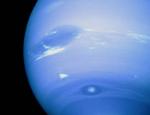 Dark Spots on Neptune
Dark Spots on Neptune
21.08.2001
Neptune has spots. The Solar System's outermost gas giant shows a nearly uniform blue hue created by small amounts of methane drifting in a thick atmosphere of nearly colorless hydrogen and helium. Dark spots do appear, however, that are anti-cyclones: large high-pressure systems that swirl in Neptune's cold cloud tops.
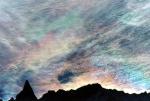 Iridescent Clouds Over Aiguille de la Tsa
Iridescent Clouds Over Aiguille de la Tsa
14.10.2003
Before the sun rose over the mountains, iridescent colors danced across the sky. The unexpected light show was caused by a batch of iridescent clouds, and captured on film in early September in Arolla, Wallis, Switzerland. The peak in the foreground of the above image is Aiguille de la Tsa.
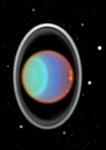 Uranian Moons, Rings, And Clouds
Uranian Moons, Rings, And Clouds
26.11.1997
The giant planet Uranus is faint and featureless when viewed in visible light. But this pair of near-infrared mosaics from the Hubble Space Telescope's NICMOS camera reveals moons, rings, and clouds of this distant gas planet.
 Venus: Earths Cloudy Twin
Venus: Earths Cloudy Twin
16.05.2004
This picture by the Galileo spacecraft shows just how cloudy Venus is. Venus is very similar to Earth in size and mass - and so is sometimes referred to as Earth's sister planet - but Venus has a quite different climate.
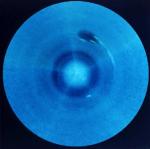 Southern Neptune
Southern Neptune
27.06.1998
Neptune, the Solar System's outermost gas giant planet, is 30 times farther from the Sun than Earth. Twelve years after a 1977 launch, Voyager 2 flew by Neptune and found surprising activity on a planet that receives only 3 percent as much sunlight as Jupiter.
|
January February March April May June July August September October November |
|||||||||||||||||||||||||||||||||||||||||||||||||